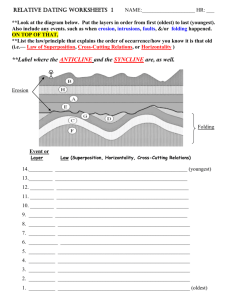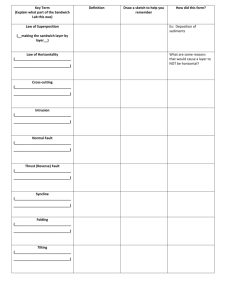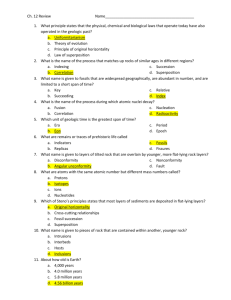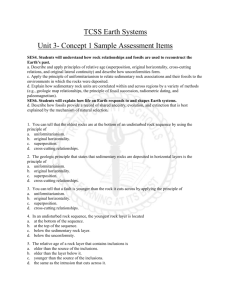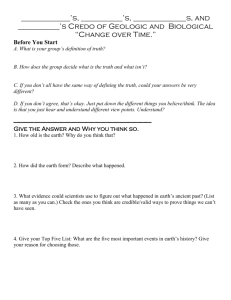Geologic Time – Part I - Practice Questions and Answers
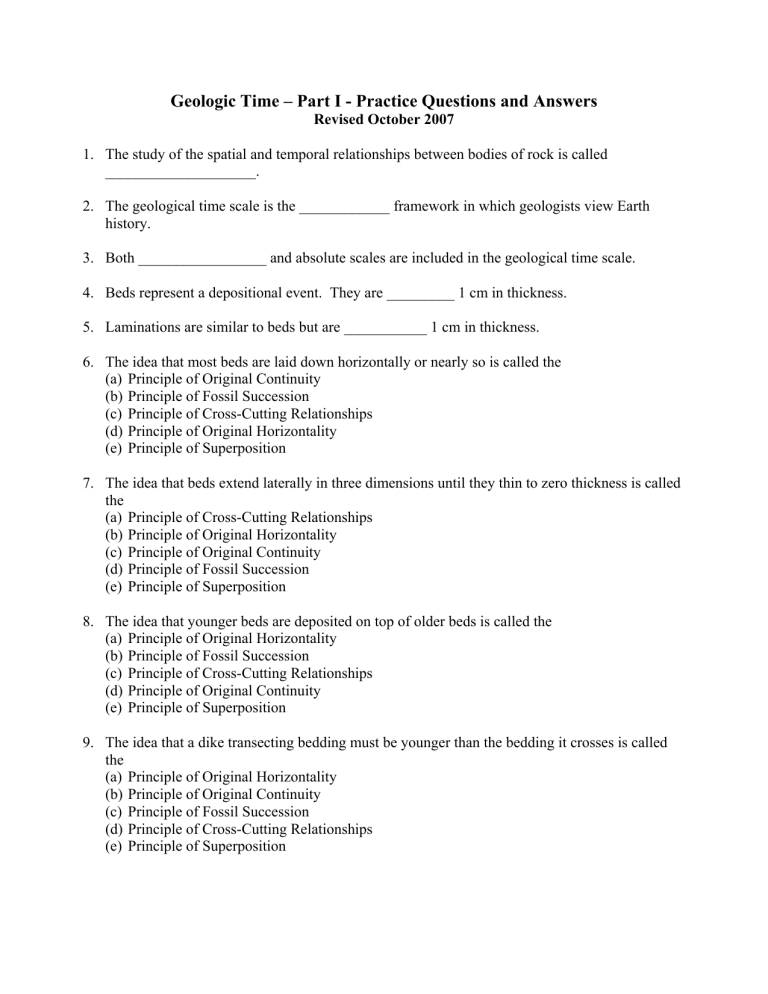
Geologic Time – Part I - Practice Questions and Answers
Revised October 2007
1. The study of the spatial and temporal relationships between bodies of rock is called
____________________.
2. The geological time scale is the ____________ framework in which geologists view Earth history.
3. Both _________________ and absolute scales are included in the geological time scale.
4. Beds represent a depositional event. They are _________ 1 cm in thickness.
5. Laminations are similar to beds but are ___________ 1 cm in thickness.
6. The idea that most beds are laid down horizontally or nearly so is called the
(a) Principle of Original Continuity
(b) Principle of Fossil Succession
(c) Principle of Cross-Cutting Relationships
(d) Principle of Original Horizontality
(e) Principle of Superposition
7. The idea that beds extend laterally in three dimensions until they thin to zero thickness is called the
(a) Principle of Cross-Cutting Relationships
(b) Principle of Original Horizontality
(c) Principle of Original Continuity
(d) Principle of Fossil Succession
(e) Principle of Superposition
8. The idea that younger beds are deposited on top of older beds is called the
(a) Principle of Original Horizontality
(b) Principle of Fossil Succession
(c) Principle of Cross-Cutting Relationships
(d) Principle of Original Continuity
(e) Principle of Superposition
9. The idea that a dike transecting bedding must be younger than the bedding it crosses is called the
(a) Principle of Original Horizontality
(b) Principle of Original Continuity
(c) Principle of Fossil Succession
(d) Principle of Cross-Cutting Relationships
(e) Principle of Superposition
10. The idea that fossil content will change upward within a formation is called the
(a) Principle of Cross-Cutting Relationships
(b) Principle of Original Horizontality
(c) Principle of Fossil Succession
(d) Principle of Original Continuity
(e) Principle of Superposition
11. An unconformity represents an absence of ________________ due to erosion or nondeposition.
12. What does surface AB represent in the following illustration?
13. What does surface ABC represent in the following illustration?
14. What does surface ABC represent in the following illustration?
15. A unit that displays a different lithological aspect relative to rocks above and below is called a
__________________________________ unit.
16. The most common rock-stratigraphic unit is the _________________.
17. Formations can be subdivided into ___________________.
18. Members can be subdivided into ___________________.
19. Two or more formations compose a ___________________.
20. All rocks around the globe that formed during the same interval of time form a
_________________________________ unit.
21. Which of the following is not a time-stratigraphic unit?
(a) eonothem
(b) erathem
(c) system
(d) series
(e) none of the above
22. The primary time-stratigraphic unit is the ___________________.
23. A system is subdivided into ___________________.
24. The stage is the ________________ subdivision of time-stratigraphic units.
25. The eonothem is the ________________ subdivision of time-stratigraphic units is the.
26. Paleontologists have traced the lineage of Homo back to Australopithecus afarenses . This now extinct ancestor of Homo lived in the Paleocene between about _______ and _______ million years ago.
27. Geological time units correspond to the time that a specified _____________________ was deposited.
28. The geologic-time unit representing the longest interval of time is the __________.
29. The geologic-time unit representing the smallest interval of time is the ____________.
30. The geologic-time unit corresponding to the time that a system was deposited is the
___________.
31. The geologic-time unit corresponding to the time that a series was deposited is the __________.
32. The geologic-time unit corresponding to the time that an erathem was deposited is the
___________.
33. The geologic-time unit corresponding to the time that an eonothem was deposited is the
___________.
34. Geologists use both ____________ and ____________ criteria to correlate strata.
35. What is the oldest age obtained from a mineral or rock on our planet?
36. How old is the Acasta gneiss and why is it significant?
37. Why is the evolution of the cyanobacteria important to the evolution of an oxygen-rich atmosphere on planet Earth?
38. During the Proterozoic, between about ________ billion years and _________ million years ago, the development of multicellular organisms with nuclei developed. These organisms eventually led to the development of the plants, spiders, fungi, and protists, and are called
(a) worms
(b) trilobites
(c) eukaryotes
(d) cyanobacteria
(e) dinosaurs
39. The first life forms on planet Earth occur during the Archean between about _______ and
_______ billion years ago, and are called
(a) eukaryotes
(b) trilobites
(c) protists
(d) prokaryotes
(e) dinosaurs
40. What is the age of the Earth?
41. The first animals with preservable hard parts first appear in the _______________?
42. Why is Cooksonia significant, and in what approximate time range did it evolve?
43. In what system is Cooksonia first found?
44. During ____________________ there were there vast swamps and peat bogs in the eastern and mid-western US. This period lasted from _________ to __________ million years ago.
45. What is Rodinia?
46. When did Rodinia form?
(a) Mesozoic
(b) Paleozoic
(c) Cenozoic
(d) Late Proterozoic (~1.1 b.y. to ~750 m.y. ago)
(e) Archean
47. The dinosaurs evolved and become dominant during the _____________, between about
________ and __________ million years ago?
48. The Great Dying occurred about _________ million years ago at the close of the
(a) Cambrian
(b) Cretaceous
(c) Triassic
(d) Permian
(e) Eocene
49. What is the age of the meteorite impact at the Cretaceous/Tertiary boundary?
50. Giant glaciers occupy the central portion of North America during the Pleistocene about
_______ million years to ____________ years ago?
51. A world-wide drop in _____________ may have contributed to the extinction of the dinosaurs by destroying their ____________ habitats.
52. An increase in ___________activity in western India, along with a drop in sea level, and a meteorite impact led to extinctions of many of the ________________, ~65 m.y. ago.
53. When did the Earth first develop an atmosphere and oceans?
54. What epoch do we live in?
55. In what period do primates first appear?
56. What is Pangaea and when did it form?
57. The Earth formed from a cloud of gas and dust orbiting the Sun. During its formation and early history it was bombarded by comets and asteroids, and its surface was probably
(a) Green and lush
(b) Covered with an ocean
(c) Rocky and solid
(d) Molten
(e) None of the above
58. List below at least one creature the lived during the Pleistocene.
59. Which of the following are possible contributors to the great extinctions that occurred at the close of the Permian?
(a) A bolide impact at Bedout High along the NW margin of Australia
(b) Eruption and formation of the Siberian Traps, and the resulting elevation of the global temperature by 5 o
C
(c) Release of methane stored under the worlds oceans
(d) Death of the dinosaurs
(e) None of the above
60. Did man evolved before or after the dinosaurs?
Answers
1. stratigraphy
2. temporal
3. relativistic
4. greater than
5. less than
6. (d) Principle of Original Horizontality
7. (c) Principle of Original Continuity or simple the Principle of Continuity
8. (e) Principle of Superposition
9. (d) Principle of Cross-Cutting Relationships
10. (c) Principle of Fossil Succession
11. sedimentation
12. angular unconformity
13. nonconformity
14. disconformity
15. rock-stratigraphic unit
16. formation
17. members
18. beds
19. group
20. time-stratigraphic
21. (e) none of the above
22. system
23. series
24. smallest
25. largest
26. 4, 2.7
27. time-stratigraphic unit
28. eon
29. age
30. period
31. epoch
32. era
33. eon
34. physical, biological
35. 4.4 billion years
36. 4.03 billion years – oldest dated rocks on planet Earth
37. Cyanobacteria utilized photosynthesis to convert light into chemical energy. The products of this process are glucose and oxygen. Hence, cyanobacteria were essential for the development of an oxygen-rich atmosphere.
38. 2.5, 543, (c) eukaryotes
39. 4.0, 2.5, (d) prokaryotes
40. 4.6 billion years
41. Cambrian
42. first vascular land plant – evolved approximately 443 – 417 million years ago
43. Silurian
44. Pennsylvanian, 323, 290
45. first supercontinent to form on planet Earth
46. (d) Late Proterozoic (~1.1 b.y. to ~750 m.y. ago)
47. Mesozoic, 248, 65
48. 248, (d) Permian
49. 65 million years
50. 1.8, 10,000
51. sea level, coastal
52. volcanic, dinosaurs
53. Archean - ~4.0-2.5 b.y. ago
54. Holocene
55. early Tertiary
56. second supercontinent to form on planet Earth - ~248 m.y. ago
57. (d) Molten
58. Cro-Magnon, wholly rhinoceros, mammoth, saber-tooth cat, etc.
59. (a), (b), and (c) are all possible contributors to the great extinctions at the close of the Permian –
However, please be aware that some (many) scientists do not accept the evidence for (a) a bolide impact at Bedout High
60. after
